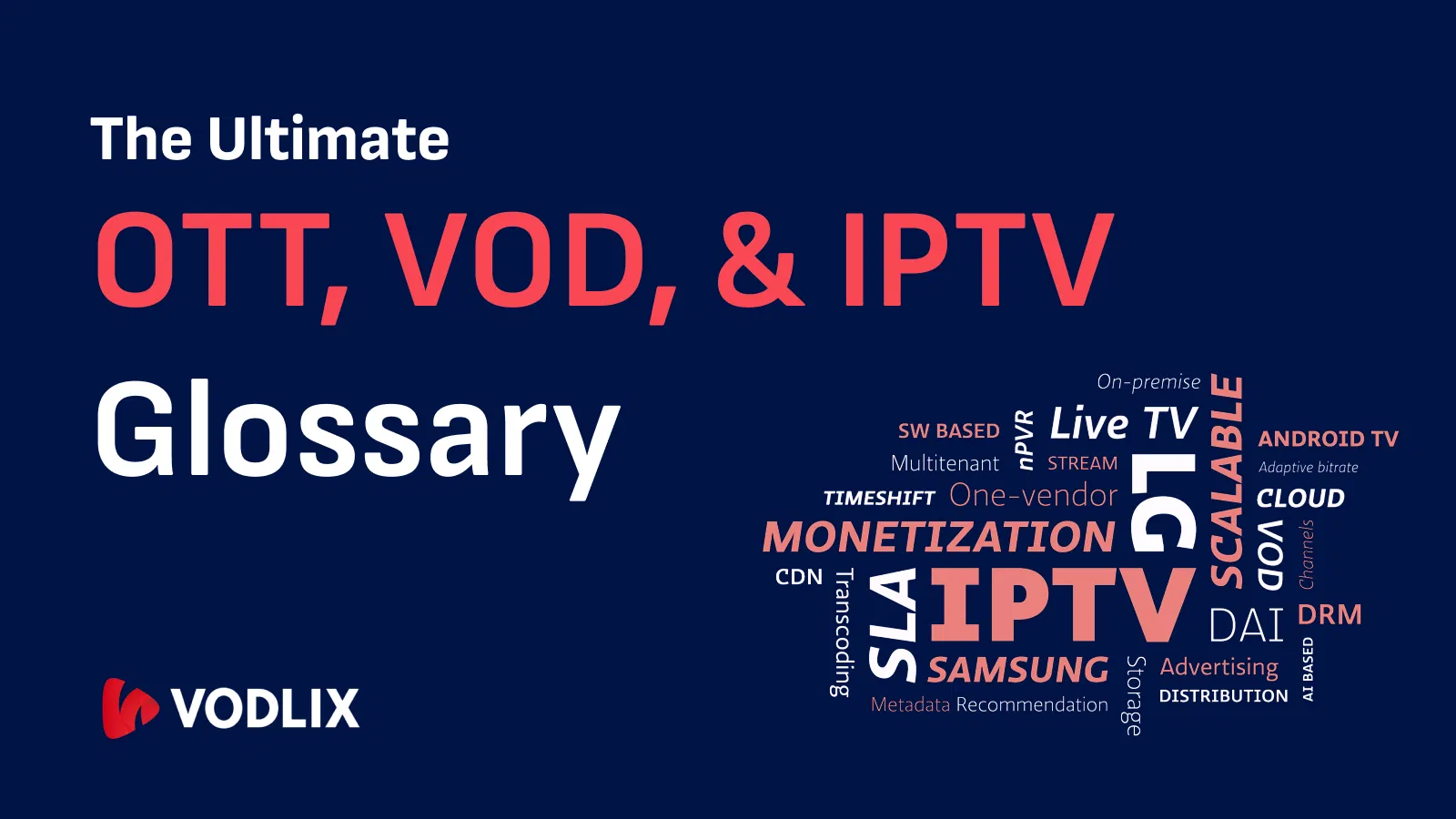Understanding OTT services requires knowledge of specialized terms that define content delivery, monetization, technology, and user engagement. The following guide combines insights from various industry sources to provide a broad understanding of OTT terms, covering content models, technologies, monetization, and viewer engagement.
OTT Core Concepts
1. OTT (Over-the-Top)
OTT refers to the streaming of media content directly over the internet, bypassing traditional cable or satellite distribution. OTT allows viewers to watch content on-demand across devices like smartphones, smart TVs, and computers.
2. VOD (Video on Demand)
Allows viewers to select and watch video content whenever they choose, without a fixed broadcast schedule. VOD services can be free (AVOD), subscription-based (SVOD), or transactional (TVOD).
3. AVOD (Advertising Video on Demand):
A free service model where viewers watch ads to access content. This model makes premium content accessible to audiences without subscription fees, while advertisers reach targeted viewers. Examples include YouTube and Tubi.
4. SVOD (Subscription Video on Demand)
A paid subscription model that grants unlimited access to a library of content. SVOD services, like Netflix and Hulu, often offer personalized recommendations to retain subscribers and minimize churn rates.
5. TVOD (Transactional Video on Demand)
In this model, users pay per title, either through a one-time purchase or a rental fee. Apple iTunes and Amazon Prime Video offer TVOD options for users who prefer to own or rent content individually.
6. Hybrid Models
Platforms often combine AVOD, SVOD, and TVOD options to maximize reach and revenue. For example, Peacock offers both free and premium paid tiers, blending ad-supported and subscription options to meet different audience preferences
7. Live Streaming
Real-time broadcasting, often used for sports, news, and live events. Live streaming on OTT allows viewers to engage in real-time, contributing to interactive and immersive experiences.
IPTV (Internet Protocol Television)
8. IPTV (Internet Protocol Television)
IPTV delivers television content over an IP network, often operated by a dedicated service provider, unlike OTT, which can be accessed over open internet connections. IPTV is a closed network, offering content typically through set-top boxes or apps from ISPs.
9. Live IPTV
This model streams live TV channels over IP networks, making it a digital alternative to traditional cable TV. It’s commonly used for broadcasting live sports and news.
10. Catch-up TV
IPTV often includes catch-up TV features, allowing users to watch programs they missed. It’s accessible for a limited time after the live broadcast.
11. Time-Shifted TV
This form of IPTV enables viewers to pause, rewind, or fast-forward live TV, enhancing viewer control.
Linear TV
12. Linear TV
Traditional television broadcast where content is scheduled and streamed in a fixed sequence. Linear TV includes both over-the-air broadcasts and cable or satellite channels, with viewers tuning in at designated times to watch specific programs.
13. Live Linear Streaming
In OTT, live linear streaming replicates traditional linear TV by delivering real-time content through internet streaming. This includes continuous streams of news, sports, and entertainment channels.
14. EPG (Electronic Program Guide
For linear TV and IPTV, EPG is a digital guide that provides scheduling information for upcoming shows, assisting viewers in navigating content on a channel.
Technology and Infrastructure
15. Content Delivery Network (CDN)
CDNs distribute content globally through a network of servers, reducing latency and buffering. They are crucial for OTT providers in delivering smooth, high-quality streams across different regions. Examples of CDNs include Akamai and Cloudflare.
16. Encoding and Transcoding
Encoding compresses video files for efficient storage, while transcoding converts them into compatible formats for different devices and network conditions. This process is essential to maintaining video quality on various platforms.
17. Middleware
Software that connects different components within an OTT ecosystem, such as content management, ad servers, and analytics. Middleware enables seamless integration and operational efficiency, especially for platforms handling high content volumes.
18. Digital Rights Management (DRM)
DRM technology protects copyrighted content from unauthorized access and piracy. By controlling access rights, DRM ensures that only paid or authorized viewers can access premium content, securing revenue for OTT platforms.
19. Adaptive Bitrate Streaming (ABR)
ABR optimizes video quality based on the viewer’s internet speed. This technique provides a buffer-free viewing experience, adjusting the video resolution as network conditions change.
20. Latency
Refers to the delay between a live event’s broadcast and its streaming to the viewer. Reducing latency is crucial for live sports and events where real-time interaction is essential. Low-latency protocols, such as WebRTC, are often implemented to minimize delay.
21. API (Application Programming Interface)
APIs facilitate the integration of different software and services, such as payment gateways or user analytics, within OTT platforms. APIs are fundamental to customizing OTT platforms and enabling interoperability with other systems.
Viewer Experience and Engagement
22.User Interface (UI) and User Experience (UX)
UI refers to the visual elements and layout, while UX encompasses the overall experience, including navigation, ease of use, and satisfaction. A well-designed UI/UX can drive user engagement and retention by making the platform intuitive and visually appealing.
23. Personalization
Using algorithms, OTT services tailor content recommendations based on viewing habits, enhancing user satisfaction and retention. Personalization includes features like “Recommended for You” and “Continue Watching” sections.
24. Buffering
The process of loading video data to avoid interruptions. High buffering times can negatively impact user experience, leading OTT providers to prioritize solutions like CDNs and adaptive bitrate streaming to reduce buffering.
25. Multi-Device Access
OTT platforms typically allow streaming across multiple devices, including smartphones, tablets, and smart TVs. Multi-device access enables flexibility for users to watch content on the go or at home.
Monetization and Advertising
26. Programmatic Advertising
A technology-driven process that uses automation to buy and place ads based on real-time data. Programmatic advertising allows OTT providers to target viewers more precisely, maximizing ad revenue.
27. Ad Insertion (Server-Side and Client-Side)
Server-Side Ad Insertion (SSAI) integrates ads into the video stream at the server level, creating a seamless viewing experience. Client-Side Ad Insertion (CSAI), on the other hand, loads ads on the viewer’s device. SSAI is generally preferred for reducing ad-blocking and enhancing user experience.
28. Churn Rate
A metric indicating the percentage of subscribers who cancel a service. Reducing churn is a key focus for OTT providers, who use personalization, exclusive content, and user engagement strategies to retain subscribers.
29. Conversion Rate
Measures how many users subscribe or make a purchase after using a free service. OTT platforms closely monitor conversion rates, especially for free trial-to-paid conversions.
30. Watch Time
The total time users spend viewing content, a critical metric for assessing content engagement and effectiveness. High watch times often correlate with customer satisfaction and indicate successful content strategies.
Analytics and Performance
31. Viewer Analytics
OTT platforms rely on data to understand viewing patterns, preferences, and behaviors. Analytics provide insights into audience demographics, content performance, and engagement, allowing for targeted content and advertising.
32. Engagement Metrics
Key metrics include play rate, completion rate, and interaction rate, which help determine content effectiveness. OTT providers use these metrics to refine content strategies and improve viewer engagement.
33. Geofencing
Restricts content access based on geographic locations. Geofencing is commonly used to comply with licensing agreements, allowing OTT platforms to manage content rights more effectively.
34. Cross-Platform Analytics
Enables tracking of user behavior across multiple devices, providing a comprehensive view of audience preferences. Cross-platform analytics helps optimize user experience and content delivery.
35. Retention Metrics
Tracks how long users stay subscribed to an OTT service. High retention indicates viewer satisfaction and loyalty, while low retention may point to issues in content offerings or platform performance.
Future-Forward OTT Trends
36. Artificial Intelligence (AI)
AI in OTT platforms enables personalization, predictive recommendations, and automated customer service. Advanced AI helps OTT providers streamline operations and improve user experience by tailoring content to individual preferences.
37. Blockchain in OTT
Blockchain technology enhances transparency in rights management and content distribution. Some OTT providers are exploring blockchain for secure, decentralized control of digital assets and to manage licensing more effectively.
38. Virtual Reality (VR) and Augmented Reality (AR)
VR and AR content are emerging trends in OTT, creating immersive experiences for viewers. VR concerts, sports, and AR-enhanced narratives provide innovative ways to engage audiences.
39. 5G and OTT
The rollout of 5G technology promises faster streaming, lower latency, and enhanced video quality, opening new possibilities for high-definition and real-time content on mobile devices.
Conclusion
The OTT industry is evolving at a rapid pace, bringing new terminologies, technologies, and viewing models to the forefront. Familiarity with these terms is essential for businesses navigating the streaming landscape, as well as for viewers looking to make the most of these services. From AVOD and SVOD models to advanced analytics and AI-driven personalization, each component shapes the OTT experience. At Vodlix, we stay ahead of these developments, delivering high-quality, accessible streaming solutions that reflect the latest in OTT advancements. Whether you’re looking to expand your content library, optimize ad revenue, or improve viewer engagement, understanding OTT jargon is key to making informed decisions in this dynamic industry.



.png)


